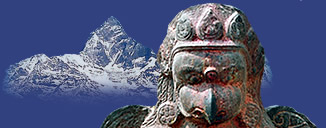 |
| Kumari - The living Goddess |
|
|
| New Kumari, a living goddess, selected |
July 10, 2001
| A 4-year-old girl has been enthroned as the new living goddess "Kumari." |
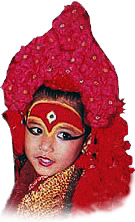 |
The
new Kumari Preeti Shakya, who is four years old, is considered young by
the standard of living goddesses who are usually five or above. This
is probably the seond or third time that this has happened. Kumaris are
usually selected from a particular Kathmandu community, and should have
no physical blemishes. or deformities. They should also show no fear when
spooked with scary objects in a darkened room as a part of the selection
process.
The royal priests and officials responsible for the affairs of the Kumari had spent the past few months looking for the new Kumari. Though the process of both selecting and "testing" the candidates is a very secret process, it is believed that the new Kumari has to be perfect with all the 32 "lachhins" (good qualities) and from a pure Shakya family, who number just a handful. |
During their search for a new Kumari, the priests hit a lot of snags with many families not ready to give their daughter away to become the living goddess with most parents opting for their daughters to take up careers like engineer or doctors.
Preeti Shakya left her home at Itumbahal and moved into the Kumari House at Hunumandhoka today which will be her home until she reaches puberty. The parents of the new Kumari ,Surendra Man Sakya and his wife Reena, were overwhelmed with joy
The new Kumari was taken into the Kumari House amid a special ceremony where traditional religious rituals by the Royal priests were performed. A special necklace was transformed to the new Kumari during the ceremony. As per tradition, she was taken to the Royal Palace this week for an audience and seeking approval of His Majesty the King Gyanendra .
Old
Kumari
The old Kumari, now aged 14, also from the same neighbourhood, was carried back to her house amid a colourful ceremony. For the next four days, there will be religious pooja at her house too. On the fourth day, priests from the Kumari House will come to her and take away all the jewellery she is wearing. Then she will be a "mortal" once again.
Tradition
of Kumari
The tradition of Kumari goes back to the Lichhabhi era but the Kumari House was believed to be built by Malla King Jaya Prakash Malla around 1814 B.S. During the Indrajatra Festival just days before Dasain, the new Kumari will be taken around on a chariot pulled by humans through the traditional route in the heart of the city.
It is believed that once the Kumari reaches puberty, a new one is chosen and the day she starts to menstruate, the new one is enthroned. Once a Kumari bleeds, then she loses her status as goddess and is reduced to the status of a mere mortal. There are about eight former Kumaris in the valley and many of them are still unmarried.
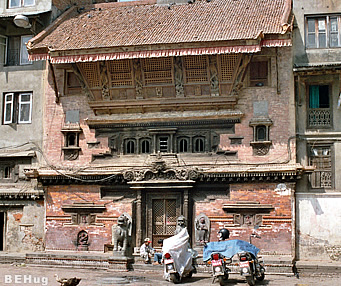 |
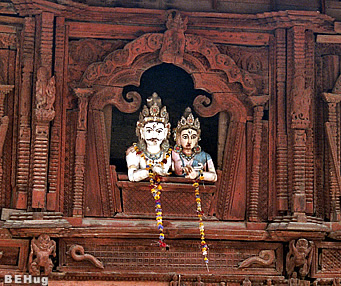 |
| Indra Jatra: King receives tika from new Kumari and offers puja to living goddess |
September
01, 2001
His Majesty King Gyanendra Bir Bikram Shah Dev worshipped the new Kumari, the living goddess, and received tika from her. His Majesty the King also worshipped Bhairav and Ganesh and received tika and prasad from them. Other members of Royal family also worshipped the Kumari. It is the first time that the new King worshiped the new kumari. Today is the third day of Indrajatra, in which Lord Indra, god of rain, is worshiped hoping good weather and good crops. Indra Jatra has been observed for more than 800 years. Three separate chariots containing Kumari, Ganesh and Bhairav were pulled in Kathmandu today to observe the main day of Indrajatra, the festival of Lord Indra. Indrajatra is the day when the Kumari appears in public.
King Gyanendra offers puja to Kumari
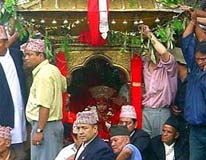 |
|
Thousands of people, including the tourists, braved the drizzle to gather at the periphery to watch this traditional chariot festival, held once a year. Indra Jatra, primarily celebrated by the Newar community in the Capital, is considered to be the most important festival, prior to the biggest festival of Dashain.
The third day of the eight-day Indra Jatra, is the most important day as the Goddess Kumari is taken out of the Kumari House in a chariot. Before taking out in a chariot, Pancha Buddha (mainly from Bajracharya community) offered a special puja to the Goddess in a secret function. Then Ganesh and Bhairab were brought out of their respective houses in different chariots amidst the beat of traditional musical instruments. Before the start of chariot festival, goats were sacrificed at each wheel of the chariots and were offered puja so that the chariots would not meet an accident during the procession.
The third day's Yatra is also called Koniya Jatra. This is because the chariots moved only towards the southern part of the city like Chikanmugal, Lagan Tole, etc. On the fourth day, Thaniya Jatra would be held, when the chariots would be taken through the northern part of the city. Starting from the Kumari House at Basantapur, the chariots would be taken through places like Pyaphal, Yatkha, Nardevi, Tangal, Bangemudha, Ason, Keltole, Indrachowk, Makhan, Hanumandhoka and back to Kumari House. Panche Baja, the traditional music and a military band accompanied the chariots. Raj Khadga (a traditional Royal Sword representing the King) is also taken along with the chariot. When the chariot of Kumari reached in front of the Bhairab temples, displayed at different places from the first day of the festival, then the people hustled for Jaad (traditional liquor) poured from the Bhairab's mouth. A pipe is fixed on the mouth of Bhairab from where the liquor is poured, people say.
Newars in the Valley invited their relatives and close ones to their homes as they organized a feast at the places where the chariot of the Kumari reached today. Then after the evening puja, the family members of those deceased in a year go around different parts of the Valley lighting oil lamps (Pala) at different parts of the city in their memory.
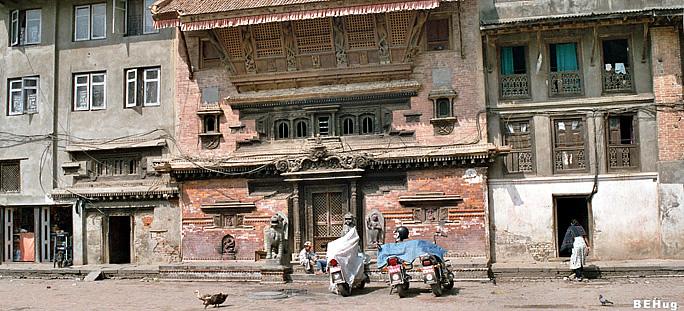 |
